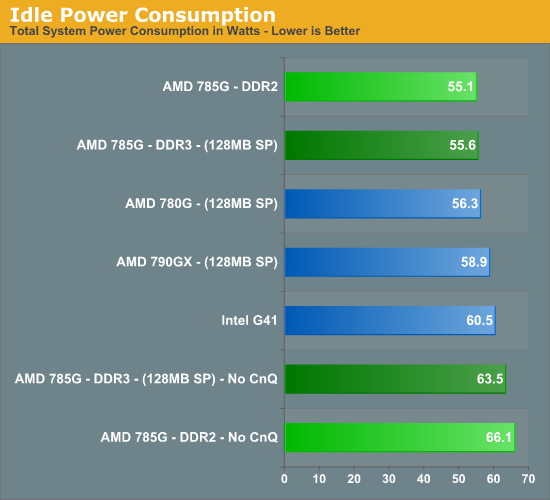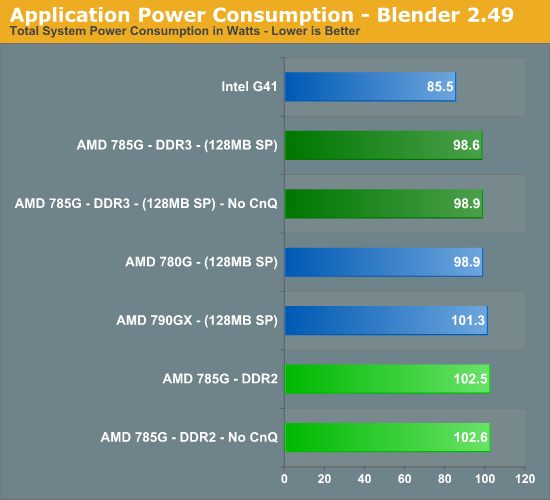AMD's 785G Chipset - Revolutionary or Evolutionary?
by Gary Key on August 4, 2009 5:00 AM EST- Posted in
- Motherboards
Power Consumption testing on the AMD platforms is always a hit or miss event. Either all the stars are aligned, more like the BIOS and driver sets are matched perfectly, or we enter the black hole known simply as Cool-n-Quiet. We had more problems getting CnQ to work properly on our early review samples than California does getting a balanced budget in place. Honestly, we have to wonder just how hard it can be to get the BIOS code in this area to stay consistent.
The reason we mention this is that just about every board had a problem with it. The first BIOS works but something else needs tuning, the second BIOS breaks CnQ, then the third fixes it, and the fourth revision breaks it again. On and on it went until Friday when not only did solid BIOS releases appear but also drivers that matched up with them.
That said, AMD has made further improvements in the PowerPlay technology utilized on the 785G. The stream processors normally run at 500MHz under full load, but PowerPlay now constantly adjusts clock speeds based on GPU utilization rates. In fact, the core will scale down to 60MHz when idling. In addition, the internal clocks inside the 785G will scale dynamically to save power regardless of voltage settings.
We have already looked at power consumption in individual tests. This time we are measuring total system power consumption, except for the monitor and A/V equipment, at the wall using a Watts Up Pro power meter. Our results were taken at idle and while rendering a large scene with Blender 2.49 x64. We measured with all power management options enabled except on the AMD systems were we also list “No CnQ” results. Windows 7 is set to balanced mode in all of our tests.
Our Gigabyte 785G DDR2 board required that we set CoreVid manually as it would default to 1.392V with our Athlon II X2 250 processor instead of 1.315V. We set voltage to 1.350V, which resulted in a true reading of 1.332V, still higher than default. This will affect the load numbers as CnQ properly set idle voltages to 0.920V.


In the idle test, both of the 785G boards pull the fewest watts. The G41 looks like a gas guzzler compared to the other boards although an idle rate of 60.5W is nothing to get upset about. Once CnQ is disabled, the 785G boards draw about 18% more energy on average.
The tables are turned in the load test. The Intel G41 system is 4% slower in performance in this title compared to the AMD 785G platforms, but uses 14% less energy coming across the finish line. You can either take the energy savings and wait a little longer or get the task over with sooner depending on your work habits. We prefer less time but do not want another iceberg lecture from Al Gore.










43 Comments
View All Comments
MrCommunistGen - Tuesday, August 4, 2009 - link
I was really curious about that section so I'm glad that I can actually view it. Thanks!fic2 - Tuesday, August 4, 2009 - link
I find the choice of a 10k RPM VelociRaptor odd for either HTPC or integrated graphic system. I have my doubts that it would be the HD choice of either user profile.b15h09 - Friday, August 7, 2009 - link
VelociRaptor because it eliminates a potential bottleneck. This isn't a real world system test.Taft12 - Tuesday, August 4, 2009 - link
Yes, I would expect a WD Greenpower drive or one of those new slow-spinning Seagates.Fox5 - Tuesday, August 4, 2009 - link
I remember roadmaps putting the 880G launching this month, but we're just getting the 785G. The 880G seems to be the chipset worth waiting for. Virtualized 3d hardware? Yes please.fzkl - Tuesday, August 4, 2009 - link
A lot of us know that when it comes to an HTPC, Intel is the worst option of the lot. To make things fair, why isn't this a 3-way roundup with the Nvidia GeForce 9300?rtallmansu - Tuesday, August 4, 2009 - link
Even more odd to me is why you would compare an Intel G41 with a ICH7 and not a G45 chipset with the newer ICH10. G41 buyers are not interested in any of these performance metrics, were as someone might want to know how the G45 compares for HTPC duties in HD playback.Shaffan - Tuesday, August 4, 2009 - link
Such a pity you did not test the RAID performances : RAID5 in particular. I heard the integrated RAID5 of Intel chipset is much better than the one of AMD, but I can't find a decent comparative test about this !flipmode - Tuesday, August 4, 2009 - link
SB710 = no RAID 5mybook4 - Tuesday, August 4, 2009 - link
Gary, you put in a lot of effort into this article, thank you! However, I found one part misleading.Most of the application benchmarks are dependent on only cpu, not gpu. It confused me that these benchmarks were in an article that compared 780G vs G41. I understand if you were trying to compare the platforms as a whole, but wouldn't that also constitute a component price match (price an amd 780g system with an equal priced G41 system then compare).
PS. I am a little sick of people saying that anything under 60fps is unplayable. Most people that frequent this site play Crysis at under 40fps.